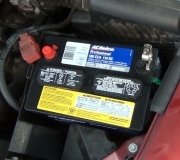I'm not sure where or how you're checking, but yes, 0.156 amps is 156 milliamps, and that's too much. Chrysler says that with 35 ma, the battery will start the engine after sitting for three weeks. Unless specified differently by the manufacturer, that is pretty much the industry standard. Cadillac is one notable exception due to the insane need to hang a computer onto every conceivable part of the car that never needed a computer before. They specify 50 ma is okay.
There's a couple of problems though with measuring current drain on cars with computers. First of all, some of them have to time out and go to "sleep mode" after as much as 20 minutes. Until then they can draw over three amps. You have to do any current testing after that has occurred. Second, all volt / ohm / amp meters use "break-before-make" range switches and you may have to move the positive test lead to a different jack for some of the current ranges, (particularly the 10 amp scale). Switching ranges momentarily opens the circuit, and a computer will respond to that by waking up again and drawing that high current. You start out on a high current range to avoid blowing its internal fuse, then, to get more accuracy, you must switch to a lower range. You need to use a jumper wire to short out the meter while you change the range. That will prevent a computer from waking up.
Once you narrow down the excessive current by removing a fuse, you'll want to reconnect the jumper across the meter, switch back to a higher range, THEN reinstall that fuse, remove the jumper, and observe the reading. Doing it in that order will avoid blowing the meter's 2 amp fuse if you woke up a computer on that circuit. If the reading is still low, connect the jumper again, then switch back to the lower scale. What this boils down to is you can remove a fuse to verify that's the circuit that makes the current draw go away, but it's hard to double-check by putting the fuse back in. That's where many people become confused.
Once you identify the fuse for the offending circuit, narrow it down by looking for smaller fuses it feeds and test each of those circuits. If this is the last fuse, you'll only have a few things to look at. One of the more common causes on GM products is the radio display failing to turn off. The clock will turn on for a few seconds when you press the volume knob, but if it stays on it will kill the battery in a few days. Trunk and under-hood bulbs draw more than half an amp, (500 ma), so bulbs are not likely suspects in this case.
Monday, November 11th, 2013 AT 2:49 PM

